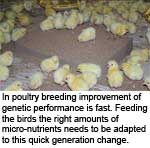Feeding poultry genetics of today

DSM Nutritional Products organised the “Feeding the genetics of today” conference during the International Poultry Exhibition in Atlanta, USA. Renowned scientists and poultry genetic companies Cobb and Aviagen shared their innovative proposals on feeding the ever-improving genetics in the poultry sector, with emphasis on antioxidants, vitamins and enzymes.
By Dick Ziggers
Dr. Pelayo Casanovas of Cobb Europe, spoke on improving male breeder performance and the quality of the day-old-chick. Cobb’s research has shown that feeding the breeder with essential nutrients such as canthaxanthin (Carophyll Red) and 25-hydroxy vitamin D3 (Hy•D) will not only improve hatchability, but will also have a positive impact on the liveability and the quality of the hatched chick.
Casanovas analysed individual male growth curves to promote best fertility peak and maintenance. Research at Cobb showed that the testes grow in weight until about 31-32 weeks of age and then slowly decline in weight again. Flock management has to be adapted to this natural process to ensure maximum testicular development and to slow down the age-related decline in fertility.
Once management is optimised on the male side to obtain maximum fertilisation rates for the eggs, further emphasis must be put on achieving top chick quality and first week performance. “Today many researchers believe that what goes on in the development of the chick from three days before hatch to three days after hatch greatly determines end performance,” says Casanovas. “Incubation and first week progress is becoming more and more relevant as growout days have been reducing due to genetic progress.”
Nutrient transfer to the embryo is crucial for good development. Breeders do not transfer all nutrients with same efficiency, particularly when they are very young or very old. DSM and Cobb started a research project on breeder nutrition, breeder and broiler performance and interactions with brooding (first week after hatch) conditions. In a preliminary field study methodologies were tested, among others adding of canthaxanthin to breeders to evaluate improvements in chick quality. Canthaxanthin is used to pigment egg yolk and broiler skin (red-orange component), but can also increase the antioxidant capacity of the embryo and hence its ‘quality’ or resistance to disease (DSM-application patent). The diets also contained 25(OH)D3, an active vitamin D metabolite.
An increase in testosterone levels were observed on the males fed canthaxanthin, even when adjusting for male and testes weight. The carotenoid also significantly reduced the egg oxidation process. Cumulative hatchability to 60 weeks was 0.75% better in the canthaxanthin group. Day old chick weight, weight of yolk sac/chick weight ratio did not show significant differences. First week broiler (300,000 broilers in test) mortality was lower in the canthaxanthin group (1.7% vs. 2.6%) and this figure correlated well with final mortalities at 50 days (6.69% vs. 7.72%). Although nutrition is only a part of the management efforts to improve chick quality, these preliminary trials show that additional feed additives in breeder feeds can contribute to improving breeder and broiler performance.
Vitamin nutrition
The continuous advances in genetics and the consequent changes in breeder performance were addressed by Dr. Michael Kidd, Mississippi State University. With more than a 1% improvement in feed conversion per year, breeder feed requirements should be carefully reviewed and improved every year; especially in essential nutrients such as vitamins and minerals.
It is quite difficult to determine vitamin needs of breeders. Hen research is timely and expensive. The “most recent” official data are from NRC 1994. Since then genetics and management of breeders have considerably changed. Therefore an extensive variation in vitamin supplementation exists. High vitamin levels in the past may be low now if the decrease in feed intake of the hens is not taken into account. So is the feed intake of the progeny also lower and have immunity challenges, welfare and epigenetics changed?
Table 1 shows needed levels of vitamins for broiler breeders according to DSM Vitamin Supplementation guidelines. For many vitamins, additional research is needed as Kidd outlined in his presentation. For example, for vitamin A the assessment of health benefits to progeny is needed. Also the antagonism with vitamin E under practical levels for progeny responses is required. For vitamin D3 the interactions of D3 and 25(OH)D3 on hen health and progeny skeletal bone and muscle yields at processing need further studies.
Kidd concluded that vitamin needs of hens each year need to increase to keep pace with strain improvements. He also outlined that further research should focus on fat soluble vitamin potential imbalances in diets with practical vitamin specs, vitamin epigenetic effects on progeny and vitamin in ovo effects.
Optimise skeletal development
Dr. Marc de Beer, Aviagen USA reviewed nutritional strategies to optimise skeletal development in broilers. Adequate levels of amino acids, optimal combinations of minerals and vitamins or the use of vitamin D metabolites were among the strategies commented on by Dr. De Beer to optimise bone development. He highlighted the importance of vitamins and trace minerals’ quality as one of the key factors impacting optimal bone development.
In skeletal development calcium, phosphorous and vitamin D are the main constituents. Calcium requirements for bone strength are likely higher than requirement for performance, De Beer said. Ca/P ratio and vitamin D cannot be treated independently. Vitamin D is important in bone formation. Higher vitamin D3 in broiler breeder diet improves body weight gain and tibia ash in broiler progeny. It also significantly reduces the incidence of rickets and tibial dischondroplasia (TD, enlarged cartilage plug in head of tibia).
De Beer concludes that in practice, problems with skeletal development very seldom can be acknowledged from the diet formulation itself. Problems occur with poor ingredient quality (e.g. mycotoxins), which interfere with vitamin D metabolism. Furthermore, the correct use of phytase is required regarding application and mixing, degradation and matrix values. The fat source, quality and quantity can also be of influence on calcium absorption. In the mill feed mixing and heat treatment are of influence and quality of vitamins and trace minerals contribute to the quality of the feed for skeletal formation. And of course diseases such as malabsorption and enteritis have a negative impact on skeletal growth.
Enzyme influence
Dr. Roselina Angel, University of Maryland, demonstrated how to use the matrix values of the unique pure protease for broilers, Ronozyme ProAct. Savings between 1 and 3 US$/t feed can yield an immediate return to the producer taking into consideration the benefit varies according to the feeding phase of the broiler.
Protease enzymes have different classifications. They can be classified by:
• Organism (plant, animal, bacterial, fungal).
• pH activity range (acid, neutral, alkaline, high alkaline)
• Peptide bond specificity (endopeptidases, exopeptidases, or AA specific peptidases)
• Proteolytic mechanism (serine, threonine, cysteine, aspartic acid, glutamic acid or metalloproteases)
Ronozyme ProAct is a bacterial alkaline serine protease. In a serine protease the serine hydroxyl group of the protease conducts the neutrophyllic attack on the peptide bond (via the carbonyl carbon) of the substrate. Examples of serine proteases are trypsin, chymotrypsin and clastase. When added to broiler diets ProAct lowered feed/gain in Ross 708 broilers up to an inclusion level of 400 ppm. Compared to a negative control apparent protein and AA digestibility at 22 days increased, but the level of inclusion of the protease had no significant influence. Brazilian research shows that added protease increases digestibility of most AA in raw materials in the range of less than 1% (Methionine and Lysine in corn) to as much as 14% (Arginine in meat and bone meal). But average results for improvement of AA digestibility are around 5 to 8%. On the basis of 2008 financial data Dr. Angel calculates savings of $10,270 per million birds when a protease is added to the feed.
Black Bone Syndrome and vitamin D
Dr. Bob Fleming, Roslin Institute, tackled the issue of Black Bone Syndrome (BBS), focusing on the physiological reasons behind the problem and nutritional methods to limit its incidence. BBS appears to be common in on-the-bone supermarket samples, particularly if frozen. There are no obvious differences between producer sources examined (so far). The most likely cause of BBS is discolouration by bone marrow pigmentation, through highly porous bone. This highly porous bone type may also have implications for poultry welfare. It appears that 25(OH)D3 can mitigate the effects of BBS, but cannot entirely prevent it in frozen samples.
For further information on the proceedings, please contact:
jose-maria.hernandez@dsm.com
Source: AllAboutFeed vol 1 nr 3, 2010











